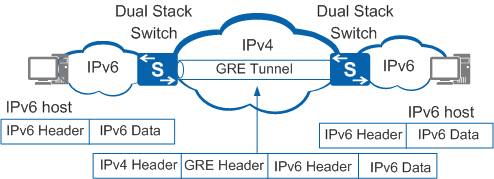IPv6 over IPv4 GRE Tunneling
Tunneling is an encapsulation technology that encapsulates packets of a network layer protocol as packets of another one. A tunnel is a virtual point-to-point (P2P) connection. It provides a path through which encapsulated packets are transmitted. Datagrams are encapsulated at one end, and decapsulated at the other end of the tunnel. Tunneling technology refers to the process that datagrams are encapsulated, transmitted, and decapsulated and is significant for the transition from IPv4 to IPv6.
Exhaustion of IPv4 addresses brings an urgent demand for the transition to IPv6. As IPv6 is not compatible with IPv4, devices will need replacing on the original IPv4 network. Replacing a large number of devices on the IPv4 network however costs a significant amount and will cause service interruption to the current network. Therefore, transition from IPv4 networks to IPv6 networks must happen gradually. During the early stage of transition, a large number of IPv4 networks have been deployed, whereas IPv6 networks remain as isolated sites over the world. You can create tunnels on the IPv4 networks to connect to IPv6 isolated sites. These tunnels are called IPv6 over IPv4 tunnels.
IPv6 over IPv4 GRE tunneling is one of IPv6 over IPv4 tunneling technologies. An IPv6 over IPv4 GRE tunnel uses the standard GRE tunneling technology to provide P2P connections. You must manually specify addresses for both ends of the tunnel. Any types of protocol packets that GRE supports can be encapsulated and transmitted through a GRE tunnel. The protocols may include IPv4, IPv6, Open Systems Interconnection (OSI), and Multiprotocol Label Switching (MPLS).
Figure 1 shows how IPv6 over IPv4 GRE tunneling works.
On a border device, the IPv4/IPv6 dual stack is enabled, and an IPv6 over IPv4 tunnel is configured.
After the border device receives an IPv6 packet from an IPv6 network, the device appends a GRE header and an IPv4 header to the IPv6 packet to encapsulate the IPv6 packet as an IPv4 packet if the destination address of the IPv6 packet is not the device and the outbound interface of the next hop is a tunnel interface.
On the IPv4 network, the encapsulated packet is transmitted to the remote border device.
The remote border device decapsulates the packet, removes the IPv4 header and GRE header, and sends the decapsulated IPv6 packet to the IPv6 network.
For details about other IPv6 over IPv4 tunneling technologies, see S2720, S5700, and S6700 V200R019C10 Configuration Guide - IP Services IPv6 over IPv4 Tunnel Configuration.
